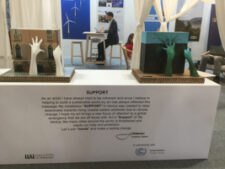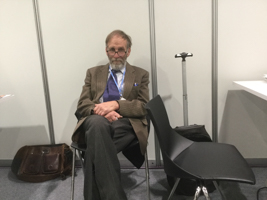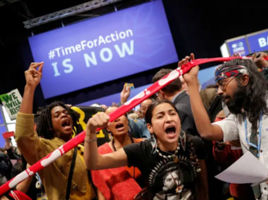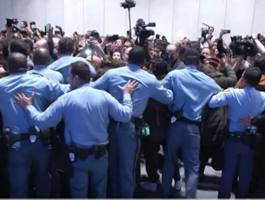Summary Report (COP25), Madrid, Spain
December, 2019 By David Simpson and Jane Lapiner
Closing Comments: One Last Chance
click on photos for larger images; uncredited photos by Jane Lapiner
The 12 day-long (It was originally intended to last only 10) 25th Conference of the Parties (COP 25), the United Nations Framework Convention on Climate Change (UNFCCC), was finally held in the cavernous halls of El Feria de Madrid (the second largest exhibition hall in Europe) but only after being born into uncertainty, bounced off its track by insurrection and directed toward a belated conclusion in near-despair.
December was not, by many standards a great month for those who deeply love our planet…unless you happened to be one of the residents of Humboldt County, California for whom biodiversity and local community self-reliance turned out to be primary virtues on a par, at least, with the development of alternative energy sources.
The event had been originally conceived in the cold autumn rains and smoky skies of COP 24 which was held in December, 2018 in Katowice, Poland. Billed from the start as the great South American COP, the 25th Conference of the Parties was scheduled to take place in Brazil the following year. For delegates and observers shivering in the Polish chill, Brazil sounded lovely, but the plan was unceremoniously dropped only a month later by the newly inaugurated, viciously anti-environmental Brazilian President, Jair Bolsonaro.
Chile’s center-right President, Sebastian Pinera, was next to curry prestige among Latin nations by offering to sponsor the UN COP. Unfortunately for him and his administration, at that same moment in history the government had instituted a small, ill-thought-out increase in Chile’s Metro commuting prices. In itself not that significant, the change fell on a populous already harboring a festering sense of inequity against the government and the select few wealthy Chileans who had come to dominate the neo-liberal, post-Pinochet economy.
This raw edge where poor and rich rubbed uncomfortably against one another had haunted the UNFCCC since its inception and now was biting them from another angle. A million people took to the streets of Santiago in protest of the cost increases. Police over-reacted, killing several protestors and injuring many more, and Pinera was forced to back out of his commitment to the COP. The very Metro station that would have been crucial to deliver delegates to the conference daily had been torched and rendered useless in the bedlam.
An incidental note on Pinera’s participation: when a Spanish judge threatened to jail him upon his arrival in Madrid for human rights abuses in conjunction with the blinding of numerous protestors in Santiago, the President of Chile found it convenient to deliver his remarks to the opening Plenary electronically from home.
Within a week and only five weeks before the originally intended start-up date of December 2nd, Spain’s stately young socialist Prime Minister, Pedro Sanchez announced that COP 25 would take place at El Feria and would proceed on time under the dual banners of Chile and Spain. Chile’s Environmental Minister, Carolina Schmidt, was named President of the COP. Thus the oft-redirected, ostensibly regional affair—now known as COP 25/Chile/Madrid 2019—was finally launched.
It’s hard to know. Certainly, the catchphrase Time for Action repeated as if on wallpaper maybe thousands of times throughout El Feria and the streets of Madrid had become by the end of the second Sunday a bad joke. Perhaps the slogan should have been It’s Way Past Time For Action—especially after 500,000 had marched in the streets of Madrid during the intervening weekend and demanded ambitious action in the halls of COP 25 during the remaining week.

This leads to a version of the overwhelming question that seems to be endemic in any climate discussion: why is it so damned hard to do the right thing especially when our future is entirely dependent on it—and we know it? We really do know the score. It may be necessary to find answers to this general query before the plethora of proposed technological, political or economic solutions can become effective.
Indeed, at the outset of this particular COP, few of these pulses were yet evident. As has become the norm at the very beginning of a UNFCCC climate event, there is usually a shared sense of urgency, an ambition to take large strides forward buffered by a subliminal sense that cooperative responses can and will be found. After two or three days, though, habit strikes once more and the primary sense of urgency descends into bickering about who pays for what and which wording gets into the concluding documents and which dumped. Progress, seems, to get diverted a little more each day the second week as mindfulness and duty are pulled into the undertow established by the existence of airplane reservations home.
COP 25 pretty much followed this form right up to its painful conclusion. There was the rousing opening plenary led by a speech from Spanish President Sanchez zealously urging the gathered negotiators to take ambitious action which, in retrospect, he himself proved helpless to accomplish. There had been several new scientific pronouncements made in the weeks leading up to December 2nd that made it once more abundantly clear that we, the species, as represented by the leadership of 196 nations, were in deep trouble.
Leading these pronouncements was the United Nations Environmental Program (UNEP) report—the Gap Report. This report says that even if all current unconditional commitments (Nationally Determined Contributions) under the Paris Agreement are implemented, temperatures are still expected to rise by 3.2°C over original levels that existed in 1870.
This, of course, will bring ever wider-ranging and more destructive climate impacts. Collective ambition must increase more than fivefold above current levels to deliver the cuts needed over the next decade to limit warming to 1.5 C. This was the agreed-upon goal coming out of COP 21 in Paris. To reach that goal now, after having waited five more years, we need to cut emissions by 7.6% per year from 2020 to 2030. To meet a 2°C goal, which is what some think is all we can achieve, we need to cut emissions by 2.78% per year.
How daunting these figures are becomes clear against a backdrop of inconvenient fact—that CO2 content in the atmosphere, instead of having been reduced annually in recent years in face of the undeniable science, has continued, over all, to rise. With the exception of the past two years, it has risen at an average of approximately 1.5% per year. Currently, world average temperatures have risen by slightly more than 1°C since 1870 when the industrial revolution is considered to have begun. Given what has taken place climate-wise in just the last few years, it is painful to imagine the world at 2 degrees C let alone 3°C or 7°C. The sky’s the limit once you unleash the wolf of carbon from any restraint. Ironically, what might be the favorite hunting grounds of those who serve the CO2 beast, carbon trading, was the most mourned aspect of the show once it was clear that serious ambition across the board was likely going for naught.
Knowing all this leads one inevitably to ask a version of the defining question. Why by the end of COP 25 was so little accomplished, so little ambition manifested, so few commitments to GHG reduction, so little assistance from those who have benefitted so greatly to those who have lost so much? Instead of being provoked into intense ambition the delegations fell once more into whining about money and picayune wording choices. Whatever happened to the annual $100 billion per year that Hilary Clinton, then US Secretary of State and representative of the G7 (wealthy countries), had promised at COP 15 in Copenhagen to donate to a fund for use of the G77 (poor countries) at COP 15. To date, that fund has failed to reach even a one-time total of$ 100 million. Perhaps Ms. Clinton clearly thought we were unable to count—or remember.
The latest version of this kind of dishonesty finally drove the activists and indigenous participants to mount a protest outside the rules of the UNFCCC. Though there were precedents in COP history—several hundred marched out of COP 15 in Copenhagen and over 700 marched down and out of the Polish National soccer stadium in Warsaw at COP 19 in protest to inaction especially on the issue of Loss and Damage. This time it was different, angrier, more impatient, approaching desperation. Greta’s recent entreaties had not fallen on deaf ears. Young people of the World over were out en masse.
The UN Police who had otherwise maintained a calm, business-like presence, were shaken into energetic, repressive action. The sight of them in their bright blue shirts, joined by local COP employees in dark suits and ties, all straining mightily against a large, solid metal gate to shove hundreds of protesters backwards out of the hall into a rain-sodden, concrete alley will not soon be forgotten. It enters the annals of depiction of great historic uprising. This time the protestors against the menace of delay and inaction didn’t walk out, they were forced out.
To be summarily pushed out of the COP was especially galling to the campaigners in light of the renewed and undisturbed presence at the COP in the unfortunately named “Green Zone” of the representatives of business enterprise. This included the We Mean Business coalition and those tireless carbon colonialists and panderers to climate profit, IETA (International Emissions Trading Association—motto; A is for Ambition). IETA held forth on dozens of exploitative schemes from their headquarters near the pavilions of several major nations.
The insistence of the Spanish Prime Minister’s speech at the opening plenary session in which he demanded ambitious action was tempered by the fact that he had solicited millions of euros at the last minute to help pay for the newly diverted event. Most of the money came from the biggest corporations in Spain and Europe, especially from the large coal, oil and gas companies (Shell, Total, BHP Billiton, Leta, Logo, et al). These presented obvious ethical and pragmatic contradictions.
Word had it that the price tag for corporate sponsorship was $2,000,000. That got your corporate imprint spread around the COP. It also bought you a kind of green proximity, a closeness to the engines of environmentalism, if you will, where policies are formulated and concepts made material. A good part of the future of the natural world is bought and sold in these hallowed halls and if you want to profit in the future, it’s not a bad idea to set up camp right there among the pavilions of the gathered nations, especially the wealthy ones.
This years’ lineup of villainy at the national level included Australia, Saudi Arabia, China, Brazil but was led by the good old US of A. Yes, that’s right, the same dubious entity that, alone among 196 nations, has announced its intended exit from the whole UN climate dialogue, the Treaty of Paris, a process that will not be complete until November 4th of this year, a day after the next election in the US. That means that Trump’s mean-spirited minions have 10 or 11 months remaining in their seemingly bottomless efforts to ruin the world. That same world is already on course for a 3-4°C (5.4-7.2°F) rise with dramatic consequences for all of us.
Two days beyond the scheduled conclusion of COP 25, a weak understanding was sort of reached and the remaining thousand or so still gathered in Madrid to save the world from human weakness limped off toward home countries several of which were already being severely punished by major changes of climate.
Alden Meyer, director of strategy and policy for the Union of Concerned Scientists, who is considered by many to be the most knowledgeable voice about the UNFCCC annual events had this judgment about COP 25:
“This is the biggest disconnect between this process and what’s going on in the real world that I’ve seen. You have the science crystal-clear on where we need to go. You have the youth and others stepping up around the world in the streets pressing for action. It’s like we’re in a sealed vacuum chamber in here, and no one is perceiving what is happening out there — what the science says and what people are demanding.“
Karen Nansen, chairperson of Friends of the Earth International added,
“People in Madrid, Santiago, and around the world are rising up and will continue to fight for environmental, social, gender, and economic justice and system change. We will continue to demand that governments be accountable to people, not to corporate polluters.“
COP 26, to be held next fall in Glasgow, Scotland, presents what could be one last chance for the UNFCCC to get it right.
*****
Two days after COP 25 finally closed without coming anywhere near the “Action” it was supposed to have been “Time For” and amid a rather commonplace set of late fall/early winter weather events back in northwestern California—an intense neighborhood dispute in rural Humboldt County over wind power and corporate control came to a head.
An aggressive power-producing outfit, Terra Gen—the biggest producers of wind power in California—had come to Humboldt a little less than two years earlier. They came with the idea of convincing the community to allow them to erect 47 or more 600 ft-tall wind generators. Such enterprise would allow the county, currently powered by relatively modern natural gas generators, to produce a third or more of the electricity they used in their homes and businesses.
Despite the enormity of the construction and the extent of the disturbance that it would require, the project had found considerable favor among the local community.
The problem to be solved, though was that the ideal locations for producing so much power from the wind just happened to be on top of two of the most perfect natural ‘hotspots’ along the California coast, Bear River and Monument Ridges. Not only were these ridges exquisitely beautifully and crucially important ecologically, they were also culturally sacrosanct to the Wiyot Band of the Rohnerville Rancheria, a Humboldt tribe that had just won back another sacred place, an island in Humboldt Bay where the greatest historic massacre in Humboldt had been committed against the Wiyot in 1860.
A completely unpredicted 4 to 1 vote by the Humboldt County Board of Supervisors closed the gate on Terra Gen, a company deeply invested in fossil fuel power as well as wind, and closed the door on the industrialization of one of the most powerful natural places—Monument and Bear River Ridges, that remain largely undisturbed along the west coast of California. The voice of the people of Humboldt and Northern California, at least, were not to be suppressed even in the name of clean energy which turned out not to be so ‘clean’ in its impact on land and community.
In the long run it was the tribal mandate of the Wiyot—backed by some elements of the environmental community—that determined the outcome. Many even in the environmental community were angry. They felt that the urgent need for clean energy outweighed the ecological and cultural considerations. Many others felt the supervisors’ decision marked a victory of biodiversity over energetics, biology over geo-engineering, survival of many species over prospering of humans alone. Now an ultimatum to replace the electric power the wind would have bought is pressing our community forward. The demand for the solarization of California’s North Coast proceeds apace.
Previous: Katowice (COP24) Summary Report












Can you be more specific about the content of your article? After reading it, I still have some doubts. Hope you can help me.